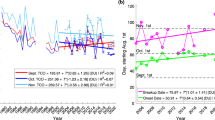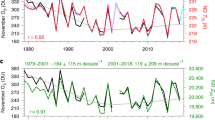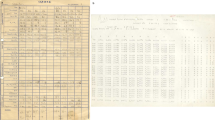Abstract
Evidence of mid-latitude ozone depletion and proof that the Antarctic ozone hole was caused by humans spurred policy makers from the late 1980s onwards to ratify the Montreal Protocol and subsequent treaties, legislating for reduced production of ozone-depleting substances. The case of anthropogenic ozone loss has often been cited since as a success story of international agreements in the regulation of environmental pollution. Although recent data suggest that total column ozone abundances have at least not decreased over the past eight years for most of the world, it is still uncertain whether this improvement is actually attributable to the observed decline in the amount of ozone-depleting substances in the Earth's atmosphere. The high natural variability in ozone abundances, due in part to the solar cycle as well as changes in transport and temperature, could override the relatively small changes expected from the recent decrease in ozone-depleting substances. Whatever the benefits of the Montreal agreement, recovery of ozone is likely to occur in a different atmospheric environment, with changes expected in atmospheric transport, temperature and important trace gases. It is therefore unlikely that ozone will stabilize at levels observed before 1980, when a decline in ozone concentrations was first observed.
This is a preview of subscription content, access via your institution
Access options
Subscribe to this journal
Receive 51 print issues and online access
$199.00 per year
only $3.90 per issue
Buy this article
- Purchase on Springer Link
- Instant access to full article PDF
Prices may be subject to local taxes which are calculated during checkout






Similar content being viewed by others
References
Crutzen, P. J. Ozone production rates in an oxygen-hydrogen-nitrogen atmosphere. J. Geophys. Res. 76, 7311–7327 (1971)
Johnston, H. S. & Graham, R. Photochemistry of HOx and HNO3 compounds. Can. J. Chem. 52, 1415–1423 (1974)
Stolarski, R. S. & Cicerone, R. J. Stratospheric chlorine: a possible sink for ozone. Can. J. Chem. 52, 1610–1615 (1974)
Wofsy, S. C., McElroy, M. B. & Yung, Y. L. The chemistry of atmospheric bromine. Geophys. Res. Lett. 2, 215–218 (1975)
Molina, M. J. & Rowland, F. S. Stratospheric sink for chlorofluoromethanes: Chlorine atom catalysed destruction of ozone. Nature 249, 810–812 (1974)
Farman, J., Gardiner, B. & Shanklin, J. Large losses of total ozone in Antarctica reveal seasonal ClOx/NOx interaction. Nature 315, 207–210 (1985)
Solomon, S., Garcia, R. R., Rowland, F. S. & Wuebbles, D. J. On the depletion of Antarctic ozone. Nature 321, 755–758 (1986)
Staehelin, J., Harris, N. R. P., Appenzeller, C. & Eberhard, J. Ozone trends: A review. Rev. Geophys. 39, 231–290 (2001)
Solomon, S. Stratospheric ozone depletion: a review of concepts and history. Rev. Geophys. 37, 275–316 (1999)
Montzka, S. A. et al. Present and future trends in the atmospheric burden of ozone-depleting halogens. Nature 398, 690–694 (1999)
World Meteorological Organization. Scientific Assessment of Ozone Depletion: 2002http://ozone.unep.org/Publications/index.asp (2003).
Weatherhead, E. C. et al. Detecting the recovery of total column ozone. J. Geophys. Res. 105, 22201–22210 (2000)
Reinsel, G. C. et al. On detection of turnaround and recovery in trend for ozone. J. Geophys. Res. 107, 4078, doi:10.1029/2001JD000500 (2002)
Reinsel, G. C. Trend analysis of upper stratospheric Umkehr ozone data for evidence of turnaround. Geophys. Res. Lett. 29, 1451, doi:10.1029/2002GL014716 (2002)
Newchurch, M. J. et al. Evidence for slowdown in stratospheric ozone loss: First stage of ozone recovery. J. Geophys. Res. 108, 4507, doi:10.1029/2003JD003471 (2003)
Reinsel, G. C. et al. Trend analysis of total ozone data for turnaround and dynamical contributions. J. Geophys. Res. 110, D16306, doi:10.1029/2004JD0046662 (2005)
Andersen, S. B. et al. Comparison of recent modeled and observed trends in total column ozone. J. Geophys. Res. 111, D02303, doi:10.1029/2005JD006091 (2006)
Velders, G. J. M. Scenario Study of the Effects of CFC, HCFC, and HFC Emissions on Stratospheric Ozone (RIVM Report 722201006, National Institute of Public Health and the Environment, Bilthaven, The Netherlands, 1995)
Rinsland, C. P. et al. Post-Mount Pinatubo eruption ground-based infrared stratospheric column measurements of HNO3, NO, and NO2 and their comparison with model calculations. J. Geophys. Res. 108, 4437, doi:10.1029/2002JD002965 (2003)
Pitari, G. & Rizi, V. An estimate of the chemical and radiative perturbation of stratospheric ozone following the eruption of Mt. Pinatubo. J. Atmos. Sci. 50, 3260–3276 (1993)
Rosenfield, J. E., Douglass, A. R. & Considine, D. B. The impact of increasing carbon dioxide on ozone recovery. J. Geophys. Res. 107, 4049, doi:10.1029/2001JD000824 (2002)
Fleming, E. L. et al. Simulation of stratospheric tracers using an improved empirically based two-dimensional model transport formulation. J. Geophys. Res. 104, 23911–23934 (1999)
Portmann, R. W. et al. Role of nitrogen oxides in the stratosphere: A re-evaluation based on laboratory data. Geophys. Res. Lett. 26, 2387–2390 (1999)
Weisenstein, D. K. et al. The effects of sulphur emissions from HSCT aircraft: A 2-D model intercomparison. J. Geophys. Res. 103, 1527–1547 (1998)
Smyshlyaev, S. P. et al. A two-dimensional model with input parameters from a general circulation model: ozone sensitivity to different formulations for the longitudinal temperature variation. J. Geophys. Res. 103, 28373–28387 (1998)
Stordal, F., Isaksen, I. S. A. & Horntveth, K. A diabatic circulation two-dimensional model with photo-chemistry: Simulations of ozone and long-lived tracers with surface sources. J. Geophys. Res. 90, 5757–5776 (1985)
Grooβ, J. U., Brühl, C. & Peter, T. Impact of aircraft emissions on tropospheric and stratospheric ozone, I, Chemistry and 2-D model results. Atmos. Environ. 32, 3173–3184 (1998)
Wuebbles, D. J. et al. New methodology for ozone depletion potentials of short-lived compounds: n-propyl bromide as an example. J. Geophys. Res. 106, 14551–14571 (2001)
Schnadt, C. et al. Interaction of atmospheric chemistry and climate and its impact on stratospheric ozone. Clim. Dyn. 18, 501–517 (2002)
Austin, J. A three-dimensional coupled chemistry-climate model simulation of past stratospheric trends. J. Atmos. Sci. 59, 218–232 (2002)
Salawitch, R. J. et al. Sensitivity of ozone to bromine in the lower stratosphere. Geophys. Res. Lett. 32, L05811, doi:10.1029/2004GL021504 (2005)
Sander, S. P. et al. Chemical Kinetics and Photochemical Data for Use in Atmospheric Studies Evaluation No. 14, JPL Publ. No. 02-25 (Jet Propulsion Laboratory, Pasadena, California, 2003).
Kirk-Davidoff, D. B. et al. The effect of climate change on ozone depletion through changes in stratospheric water vapour. Nature 402, 399–401 (1999)
Randeniya, L. K., Vohralik, P. F. & Plumb, I. C. Stratospheric ozone depletion at northern midlatitudes in the 21st century: the importance of future concentrations of greenhouse gases nitrous oxide and methane. Geophys. Res. Lett. 29, 1051, doi:10.1029/2001GL014295 (2002)
Oltmans, S. J. et al. The increase in stratospheric water vapor from balloonborne frostpoint hygrometer measurements at Washington, D.C., and Boulder, Colorado. Geophys. Res. Lett. 27, 3453–3456 (2000)
Shindell, D. T. Climate and ozone response to increased stratospheric water vapor. Geophys. Res. Lett. 28, 1551–1554 (2001)
Randel, W. J. et al. Interannual changes of stratospheric water vapor and correlations with tropical tropopause temperatures. J. Atmos. Sci. 61, 2133–2148 (2004)
Chipperfield, M. P. & Jones, R. L. Relative influences of atmospheric chemistry and transport on Arctic ozone trends. Nature 400, 551–554 (1999)
Salby, M. L. & Callaghan, P. F. Fluctuations of total ozone and their relationship to stratospheric air motions. J. Geophys. Res. 98, 2715–2727 (1993)
Hood, L. L., Rossi, S. & Beulen, M. Trends in lower stratospheric zonal winds, Rossby wave breaking behaviour, and column ozone at northern midlatitudes. J. Geophys. Res. 104, 24321–24339 (1999)
Fusco, A. C. & Salby, M. L. Interannual variations of total ozone and their relationship to variations of planetary wave activity. J. Clim. 12, 1619–1629 (1999)
Steinbrecht, W., Claude, H., Kohler, U. & Hoinka, K. P. Correlations between tropopause height and total ozone: implications for long-term changes. J. Geophys. Res. 103, 19183–19192 (1998)
Forster, P. M. & Tourpali, K. Effect of tropopause height changes on the calculation of ozone trends and their radiative forcing. J. Geophys. Res. 106, 12241–12251 (2001)
Santer, B. D. et al. Contributions of anthropogenic and natural forcing to recent tropopause height changes. Science 301, 479–483, doi:10.1126.1084123 (2003)
Zhou, S. et al. Trends of NAO and AO and their associations with stratospheric processes. Geophys. Res. Lett. 28, 4107–4110 (2001)
Appenzeller, C., Weiss, A. K. & Staehelin, J. North Atlantic Oscillation modulates total ozone winter trends. Geophys. Res. Lett. 27, 1131–1134 (2000)
Austin, J. et al. Uncertainties and assessments of chemistry-climate models of the stratosphere. Atmos. Chem. Phys. 3, 1–27 (2003)
Shindell, D. T., Rind, D. & Lonergan, P. Increased polar stratospheric ozone losses and delayed eventual recovery owing to increasing greenhouse-gas concentrations. Nature 392, 589–592 (1998)
Newman, P. A. & Nash, E. R. Quantifying the wave driving of the stratosphere. J. Geophys. Res. 105, 12485–12497 (2000)
Schnadt, C. et al. Interaction of atmospheric chemistry and climate and its impact on stratospheric ozone. Clim. Dyn. 18, 501–517 (2002)
Manney, G. et al. The remarkable 2003–2004 winter and other recent warm winters in the Arctic stratosphere since the late 1990s. J. Geophys. Res. 110, D4107, doi:10.1029/2004JD005367 (2005)
Ramaswamy, V. Stratospheric temperature trends: observations and model simulations. Rev. Geophys. 39, 71–122 (2001)
Shine, K. P. et al. A comparison of model simulated trends in stratospheric temperatures. Q. J. R. Meteorol. Soc. 129, 1565–1588 (2003)
Thrush, B. A. The chemistry of the stratosphere. Rep. Prog. Phys. 51, 1341–1371 (1988)
Zerefos, C. S. et al. Solar activity-total ozone relationships: observations and model studies with the heterogeneous chemistry. J. Geophys. Res. 102, 1561–1569 (1997)
Randall, C. E. et al. Stratospheric effects of energetic particle precipitation in 2003–2004. Geophys. Res. Lett. 32, L05802, doi:10.1029/2004GL022003 (2005)
Jackman, C. H., Fleming, E. L. & Vitt, F. M. Influence of extremely large solar proton events in a changing stratosphere. J. Geophys. Res. 105, 11659–11670 (2000)
Stephenson, J. A. E. & Scourfield, M. W. J. Importance of energetic solar protons in ozone depletion. Nature 352, 137–139 (1991)
Sinnhuber, M. et al. A model study of the impact of magnetic field structure on atmospheric composition during solar proton events. Geophys. Res. Lett. 30, doi:10.1029/2003GL017265 (2003)
Dessler, A. E. et al. Balloon-borne measurements of ClO, NO, and O3 in a dense volcanic cloud: an analysis of heterogeneous chemistry between 20 and 30 km. Geophys. Res. Lett. 20, 2527–2530 (1993)
Fahey, D. W. et al. In situ measurements constraining the role of sulphate aerosols in mid-latitude ozone depletion. Nature 363, 509–514 (1993)
Solomon, S. et al. The role of aerosol variations in anthropogenic ozone depletion at northern midlatitudes. J. Geophys. Res. 101, 6713–6727 (1996)
Prather, M. J. Catastrophic loss of stratospheric ozone in dense volcanic clouds. J. Geophys. Res. 97, 10187–10191 (1992)
Thomason, L. W., Poole, L. R. & Deshler, T. A global climatology of stratospheric aerosol surface area density deduced from SAGE II measurements. J. Geophys. Res. 102, 8967–8976 (1997)
Schoeberl, M. R., Bhartia, P. K. & Herman, J. R. Tropical ozone loss following the eruption of Mt. Pinatubo. Geophys. Res. Lett. 20, 29–32 (1993)
Hofmann, D. J. et al. Ozone loss in the lower stratosphere over the United States in 1992–1993: Evidence for heterogeneous chemistry on the Pinatubo aerosol. Geophys. Res. Lett. 21, 65–68 (1994)
Hegerl, G. C. et al. Multi-fingerprint detection and attribution analysis of greenhouse gas-, greenhouse gas-plus-aerosol and solar forced climate change. Clim. Dyn. 13, 613–634 (1997)
Hofmann, D. J. et al. Ten years of ozonesonde measurements at the south pole: implications for recovery of springtime Antarctic ozone. J. Geophys. Res. 102, 8931–8943 (1997)
Hadjinicolaou, P., Pyle, J. A. & Harris, N. R. P. The recent turnaround in stratospheric ozone over northern middle latitudes: A dynamical modeling perspective. Geophys. Res. Lett. 32, L12821, doi:10.1029/2005GL022476 (2005)
Rex, M. et al. Arctic ozone loss and climate change. Geophys. Res. Lett. 31, L04116, doi:10.1029/2003GL018844 (2004)
Fioletov, V. E. & Shepherd, T. G. Seasonal persistence of midlatitudes total ozone anomalies. Geophys. Res. Lett. 30, 1417, doi:10.1029/2002GL016739 (2003)
Prather, M. & Jaffe, A. H. Global impact of the Antarctic ozone hole: chemical propagation. J. Geophys. Res. 95, 3473–3492 (1990)
Logan, J. A. et al. Trends in the vertical distribution of ozone: a comparison of two analyses of ozonesonde data. J. Geophys. Res. 104, 26373–26399 (1999)
Randel, W. J. et al. Trends in the vertical distribution of ozone. Science 285, 1689–1692 (1999)
Bojkov, R. D. et al. Vertical ozone distribution characteristics deduced from ∼44,000 re-evaluated Umkehr profiles (1957–2000). Meteorol. Atmos. Phys. 79, 127–158 (2002)
Miller, A. J. et al. Comparisons of observed ozone trends and solar effects in the stratosphere through examination of ground-based Umkehr and combined solar backscattered ultraviolet (SBUV) and SBUV 2 satellite data. J. Geophys. Res. 101, 9017–9022 (1996)
Petropavlovskikh, I. et al. On shifts in the long-term Umkehr radiance records and their influence on retrieved ozone profiles. Geophys. Res. Lett. 28, 255–258 (2001)
Waugh, D. W. et al. Persistence of the lower stratospheric polar vortices. J. Geophys. Res. 104, 27191–27201 (1999)
Pawson, S. & Naujokat, B. The cold winters of the middle 1990s in the northern lower stratosphere. J. Geophys. Res. 104, 14209–14222 (1999)
Tabazadeh, A. & Cordero, E. New directions: stratospheric ozone recovery in a changing atmosphere. Atmos. Environ. 38, 647–649 (2004)
Rosenfield, J., Douglass, A. R. & Considine, D. B. The impact of increasing carbon dioxide on ozone recovery. J. Geophys. Res. 107, 4049, doi:10.1029/2001JD000824 (2003)
Langematz, U. et al. Thermal and dynamical changes of the stratosphere since 1979 and their link to ozone and CO2 changes. J. Geophys. Res. 108, 4027, doi:10.1029/2002JD002069 (2003)
Acknowledgements
We thank NASA GSFC, NOAA ESRL, EPA CISES, Danish National Science Foundation, EU CANDIDOZ and the Fulbright Foundation for their support of this research.
Author information
Authors and Affiliations
Corresponding author
Ethics declarations
Competing interests
Reprints and permissions information is available at npg.nature.com/reprintsandpermissions. The authors declare no competing financial interests.
Rights and permissions
About this article
Cite this article
Weatherhead, E., Andersen, S. The search for signs of recovery of the ozone layer. Nature 441, 39–45 (2006). https://doi.org/10.1038/nature04746
Issue Date:
DOI: https://doi.org/10.1038/nature04746
This article is cited by
-
Launch of an Innovative Air Pollutant Sampler up to 27,000 Metres Using a Stratospheric Balloon
Aerotecnica Missili & Spazio (2023)
-
Recent Progress in Indacenodithiophene-Based Acceptor Materials for Non-Fullerene Organic Solar Cells
Topics in Current Chemistry (2022)
-
Purification, characterization and assessment of stability, reactive oxygen species scavenging and antioxidative potentials of mycosporine-like amino acids (MAAs) isolated from cyanobacteria
Journal of Applied Phycology (2022)
-
Apportionment of long-term trends in different sections of total ozone column over tropical region
Environmental Monitoring and Assessment (2022)
-
Dynamical mechanisms for the recent ozone depletion in the Arctic stratosphere linked to North Pacific sea surface temperatures
Climate Dynamics (2022)
Comments
By submitting a comment you agree to abide by our Terms and Community Guidelines. If you find something abusive or that does not comply with our terms or guidelines please flag it as inappropriate.



